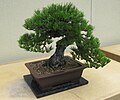Pinus thunbergii
| Japanese black pine | |
|---|---|

| |
| Pruned Japanese Black Pines in Japanese National Garden, Tokyo | |
| Scientific classification | |
| Kingdom: | |
| Division: | |
| Class: | |
| Order: | |
| Family: | |
| Genus: | |
| Subgenus: | |
| Species: | P. thunbergii
|
| Binomial name | |
| Pinus thunbergii | |
| Synonyms | |
|
Pinus thunbergiana | |
Pinus thunbergii (Syn: Pinus thunbergiana; English: Japanese black pine,[1] Japanese pine, black pine; Korean: 곰솔 ; Chinese: 黑松 ; Japanese: Kuromatsu; Kanji: 黒松) is a pine native to coastal areas of Japan: Kyūshū, Shikoku and Honshū, but not Hokkaidō ( Hokkaidō has a particular type of pine called Aikuromatsu) and South Korea.[2]
Description
Japanese black pine can reach the height of 40 m, but rarely achieves this size outside its natural range. The needles are in fascicles of two with a white sheath at the base, 7–12 cm long; female cones are 4–7 cm in length, scaled, with small points on the tips of the scales, taking two years to mature. Male cones are 1–2 cm long borne in clumps of 12-20 on the tips of the spring growth. Bark is gray on young trees and small branches, changing to black and plated on larger branches and the trunk; becoming quite thick on older trunks.
Ecology
In North America this tree is subject to widespread mortality by the native American pinewood nematode, Bursaphelenchus xylophilus, spread by means of beetle vectors. Subsequently, blue stain fungus invades the plant, leading to a rapid decline and death. This nematode has also been introduced to Japan accidentally, leading to the species becoming endangered in its native area.
Uses
Because of its resistance to pollution and salt, it is a popular horticultural tree. In Japan it is widely used as a garden tree both trained as Niwaki and untrained growing as an overstory tree. The trunks and branches are trained from a young age to be elegant and interesting to view. It is one of the classic bonsai subjects, requiring great patience over many years to train properly.
Images
-
Pinus thunbergii var. corticata Bonsai
-
Pinus thunbergiana var. corticata Bonsai
-
Well trimmed, small in Ichikawa, Chiba
-
Close up of trunk in Enoshima
-
Pinus thunbergii var. Thunderhead
Notes
- ^ USDA, NRCS (n.d.). "Pinus thunbergii". The PLANTS Database (plants.usda.gov). Greensboro, North Carolina: National Plant Data Team. Retrieved 31 January 2016.
- ^ eFloras, 2009
References
- eFloras, Missouri Botanical Garden & Harvard University Herbaria (FOC Vol. 4 Page 21), Pinus thunbergii, retrieved 2009
{{citation}}: Check date values in:|accessdate=and|date=(help)
External links






